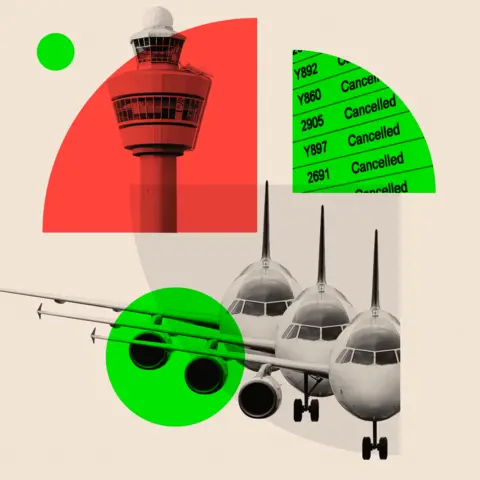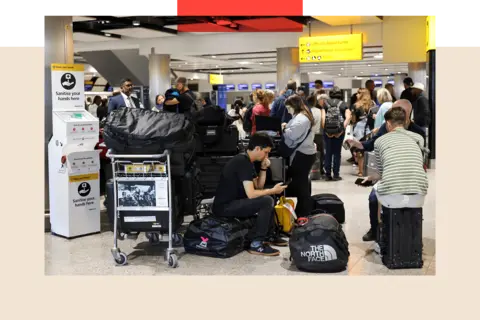ARTICLE AD BOX


7 minutes ago
By Katy Austin, Transport correspondent

 Getty Images
Getty Images
Picture this. You’ve reached the end of a much-anticipated holiday in sunnier climes with your family in tow. It’s time to fly home to the UK.
But when you reach the crowded airport, delays are starting to build. You wait and wait and then your flight is cancelled. Information is patchy. The airline should help, but it seems overwhelmed - nobody seems to know what’s going on. Alternative flights are getting booked up quickly. So too are hotels. You end up stuck for days.
That nightmare scenario is what thousands faced at the end of August last year, after an exceptional IT failure at the UK’s main air traffic services provider Nats on a bank holiday Monday. About three quarters of a million people were affected by cancellations or delays.
Last year, extreme weather events, staffing issues in some air traffic control towers and strikes in Europe all caused disruption. Overall, delays were much worse in 2023 than before the pandemic.
And in 2024, airports are expected to be even busier. Air travel is booming again. More people are flying, despite notably higher fares.
So passengers can be forgiven for worrying about more travel chaos - and asking what the industry is doing to tackle the issues that have have caused it.

 Reuters
Reuters
August 2023's flight delays were caused by technical issue at UK air traffic control
It won’t just be problems from last year that travellers remember, either. In 2022, post-pandemic staff shortages across the industry lead to chaotic scenes at some airports, and meant some airlines’ planned schedules simply couldn’t be delivered.
Although the picture so far this year is improved, just in the past week there have been examples of cancellations - a power cut at Manchester Airport, and yet another staffing issue affecting air traffic control at Gatwick Airport.
When reading stories of travel chaos, it’s easy to forget that things go fine most of the time. The majority of flights happen as they should. That’s no small feat when you consider what an enormous and constantly moving puzzle aviation is.
But when things do go wrong, for whatever reason, there’s not a lot of room for manoeuvre. Things can easily escalate.
John Grant, senior analyst at travel data firm OAG, says however hard the industry tries, resilience is “always stretched”, as “there is no spare capacity in the system”. It’s an industry run on fine margins.
This year’s high demand will be welcomed by airlines, whose finances are regaining strength after the pandemic. They make their biggest profits in the summer.
But it also means even more pressure on all parts of the industry to make sure things go to plan.
How busy will this summer be?
According to aviation analytics firm Cirium, 282,207 flights are due to depart the UK over June, July and August.
That’s still slightly below the 307,538 over the same period in 2019. But the total number of seats available, and passengers at airports, is pretty much back to where it was. Britain’s busiest airport, London Heathrow, is expecting its busiest-ever summer, with 30 million passengers - sometimes over 260,000 per day.
John Grant explains this is because, wherever possible, airlines are using slightly larger aircraft.
That means planes carrying more fare-paying passengers, without needing more pilots – who are in high demand around the world. At Heathrow, for example, the average aircraft flown in the first three months of this year was eight seats larger than the same time in 2019.
If you include “overflights”, such as those passing over to cross the Atlantic, the skies over the UK are very nearly as busy as before the pandemic.
Nats handled the equivalent of 7,340 flights a day in May. That’s 5.9% up on the same time last year. It’s anticipating summer to be 10% busier than 2023.
There’s a similar trend at Eurocontrol, which organises the airspace over the whole of Europe. It expects 7% more traffic this summer than last year, with some areas seeing 20% more than before Covid. At the same time, European airspace is still squeezed due to the Russia-Ukraine war. Eurocontrol told me it’s working with all its partners to “reduce the impact of bottlenecks” and “mitigate any disruptions”.
How will air traffic control cope?
Well-functioning air traffic control systems are crucial to ensuring all those flights happen safely and on schedule. Nats has been under the spotlight following that incident last August.
From control centres in Swanwick, Hampshire, and Prestwick, Ayrshire, Nats manages the 2.5 million flights per year that cross the UK’s upper airspace - and part of the Atlantic. The organisation also has a commercial arm that provides services at the control towers of 15 UK airports, managing the final approaches of planes as they land or take off.
At the Swanwick control centre, I meet Nats’ chief operations officer Kathryn Leahy. In the room where we stand, all flight due to land at London’s multiple airports, including Heathrow and Gatwick, are kept a safe distance apart before different staff in control towers at airports take over for their final approaches.
At Heathrow, things are particularly tight: a plane lands or takes off every 45 seconds at peak times.


Kathryn Leahy insists Nats is ready for the summer
“Busy hours are as busy as they were in 2019,” Ms Leahy says. “So for all intents and purposes we are back to normal.”
The IT failure last year prompted stinging criticism from airlines, who say the incident cost them tens of millions of pounds. The automated system at Swanwick couldn’t understand part of an unusual flight plan, and responded by shutting down. It took hours to rectify, leaving controllers to process flight plans manually – a much, much slower process.
When you think about the volume of traffic being handled, it’s clear why that had such a big impact and why it took so long to resolve. Trade body Airlines UK has since branded Nats’ basic resilience planning and procedures “wholly inadequate”.
Nats has said the exact same issue could not occur again due to a software fix that was found within days and has promised improvements.
Ms Leahy insists Nats is well-resourced for the summer, with engineers, air traffic controllers and assistants on site around the clock. “The priority has absolutely been making sure we’re ready for the demand that’s coming,” she says. She says “no organisation can confirm nothing will happen”, but points out that since last summer, a number of big-traffic days including bank holidays have passed without incident.
An interim report by an independent panel found that communication issues on 2023’s August bank holiday had "resulted in more uncertainty and more severe impacts on passengers and others than was necessary".
Nats says not only has it “renewed” its crisis response and engineering support processes, but communication with airports and airlines has also been improved - something that Ms Leahy says is crucial.
Daily 16:00 meetings with them have been re-introduced for the first time since before the pandemic. “Demand and traffic for the following day, and known weather situations that might be developing” are discussed, and any other potential issues flagged.


When events happen, “we are at the crow’s nest”, says Ms Leahy. “So having those calls, keeping our airline and our airport partners and passengers up to date is in our gift.”
The impact of unexpected problems at busy times can be likened to a lane being closed on the M25 motorway at rush hour: lots of traffic to manage, trying to come off at different exits. Congestion can quickly appear.
The main tool Nats has to safely control situations is known as a "regulation”: this involves reducing the number of flights that can get into any given airport in a particular hour. It can switch off, and switch back on, the flow of planes.
Sometimes disruption is caused by something outside the aviation industry’s control. For example, a nationwide Border Force system failure earlier this year led to queues forming as E-gates stopped working.
Ms Leahy said it set up a team to monitor in case airports began to fill up with aircraft on the ground full of passengers unable to get off: “Where you’ve got airports that are full, all the parking spaces are full, you go into what’s called a mass diversion plan.” In the end, it wasn’t necessary to divert any flights - but that could have been the knock-on effect.
Analyst John Grant points out there is “little spare capacity at the big airports to accommodate if there’s disruption“ - so missing a designated slot can lead to a big delay.
Then there’s the ongoing issue of an international shortage of air traffic controllers. Staffing problems at control towers caused some disruption last year, particularly at Gatwick - where shortages have again caused cancellations this month.
Ms Leahy said the training of controllers had stopped during the pandemic, when not enough flights were in the sky for controllers to be trained in live scenarios.
She insisted the organisation’s training pipeline is now “as full as it possibly can be”, and described herself as “confident but not complacent” for the coming summer.
What about airlines and airports?
Nats is far from the only organisation focussing on resilience.
It’s a big theme for airlines like EasyJet, one of Europe’s largest. The summer peak is already here and the low-cost carrier is taking about 310,000 passengers on more than 1,900 flights each day. Its planes complete an average of eight flights per day and as many as 325 of them can be in the sky at a time.
If anything happens to leave aircraft and crews in the wrong place, the volume and complexity of the packed international schedule means disruption can quickly build up.
EasyJet’s operations are co-ordinated from its new expanded “Integrated Control Centre” in Luton. With the runway and air traffic control tower of nearby Luton Airport visible in the distance, I spoke to the airline’s Director of Network Control, Gill Baudot.
She said the business spends most of the winter learning from the previous summer. Measures EasyJet has focussed on include having enough standby crew available.
It has also built “firebreaks” into its programme. This means longer turnaround times than the usual 35 minutes on longer flights, Ms Baudot says, “so we’ve got more time to pick up from any issues... so we can get more of our aircraft away on time.” Otherwise, “once you start of go off schedule it’s really hard to bring it back”.
The airline says it now has 14 standby aircraft across its network. If a plane gets delayed early on, rather than letting delays accumulate over the day, a spare aircraft and crew can be “injected” to take on the second half of the programme.
Ms Baudot says that makes a huge difference, “because then you’re not over-running into the following day, you’re not ending up with very last-minute overnight delays or last minute cancellations”.
Post-Brexit rules are an additional complication, as UK and EU crews can’t operate interchangeably.
If flights have to be cancelled, the airline can see which ones have the most vulnerable customers or children on board, and try to prioritise.
It’s not all reactive. Tech tools can predict things like how air traffic control strikes in Europe might affect schedules.
Such strikes are common summer occurrence and likely again this year, although a new rule in France requiring 48 hours’ notice has made them easier to deal with.
A common complaint from passengers using any number of airlines is a lack of staff on the ground to help them. EasyJet says it has put more customer service staff in place at bigger airports.
Staffing is another area airports will have been focussing on.
Heathrow, for example, said it had increased the number of staff at terminals to help passengers, and invested in a team to help ground handlers – who are the airlines’ responsibility – with baggage so that baggage services are “robust”.
There’s still some concern in the industry about passengers’ understanding of carry-on liquids rules - and the potential for non-compliance to cause queues and even disruption.
Most major UK airports have kept the 100ml limit for containers in hand luggage for now, as the rollout of new high-tech scanners has been much delayed.
A number of smaller airports did install them on time, and scrapped the old liquids limit – only to be told by the government to re-instate it earlier this month, after new “information” was received about the equipment. It’s unclear how long that situation will last, and there’s already been confusion in some places.
What’s certain this year is that air travel is going to be busy.
However, what remains to be seen is where any problems will pop up this time - and if all the resilience measures the industry says it’s doing, will be enough.
BBC InDepth is the new home on the website and app for the best analysis and expertise from our top journalists. Under a distinctive new brand, we’ll bring you fresh perspectives that challenge assumptions, and deep reporting on the biggest issues to help you make sense of a complex world. And we’ll be showcasing thought-provoking content from across BBC Sounds and iPlayer too. We’re starting small but thinking big, and we want to know what you think - you can send us your feedback by clicking on the button below.

 6 months ago
24
6 months ago
24








 English (US) ·
English (US) ·